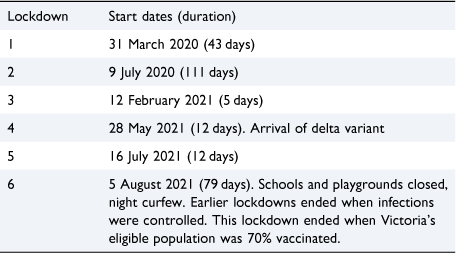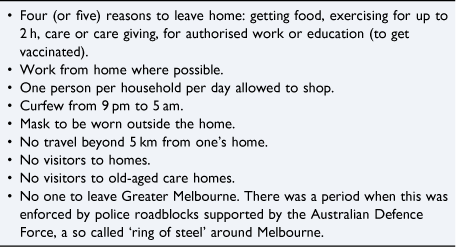Reflections from Melbourne, the world’s most locked-down city, through the COVID-19 pandemic and beyond
Ian Macreadie *Microbiology Australia 43(1) 3-4 https://doi.org/10.1071/MA22002
Published: 28 April 2022
© 2022 The Author(s) (or their employer(s)). Published by CSIRO Publishing on behalf of the ASM. This is an open access article distributed under the Creative Commons Attribution-NonCommercial-NoDerivatives 4.0 International License (CC BY-NC-ND)
Melbourne, Victoria’s capital city, has had more lockdowns (Table 1) due to the COVID-19 pandemic than any other city in the world. With its population of 5.5 million people Melbourne has a well developed economy based on high technology services, education, sports, arts, events and tourism. Most of these activities were all deeply affected by 262 days of lockdowns with Melburnians issued stay-at-home orders except for permitted activities.

|
Lockdown measures varied somewhat on each occasion. Some are listed in Table 2.

|
The adverse effect of lockdowns on morale and mental health was experienced in Melbourne and other places where there were lockdowns, however, the sheer number of lockdowns, their duration, and the uncertainties due to different rules in different jurisdictions made the lockdown experience in Melbourne even tougher. The Victorian government provided financial support for most workers who had lost income from their regular work due to the restrictions. However, the criteria for assistance was not met by many who worked in casual positions. These people included the many foreign students who normally supported themselves through casual employment. It also included many senior students who practiced their skills as laboratory demonstrators.
By late 2021, Melbourne moved out of lockdowns and into a highly enviable position, becoming one of the most vaccinated places in the world (90% vaccinated as of late November 2021). Now Melbourne provides an example of what can be achieved with a high vaccination rate.
What led to the high vaccination rate?
The major reasons for Melbourne’s high vaccination rate are likely to be the following.
(1) Lockdowns: The lockdowns (Table 1) were a major reason for high vaccination rates. Prior to vaccines, elimination or suppression of transmission were the only options for people to avoid COVID-19. Australia is an island continent that was relatively easy to isolate from the rest of the world for almost 2 years by international border controls. Australians were ordered ‘Do Not Travel’ and ‘essential travellers’ arriving were made to undergo hotel quarantine for 2 weeks. In addition, to restrict internal movements, the six states and two territories frequently closed their borders during 2020 and 2021 to limit SARS-CoV-2 spread. In some instances, just one infected person being identified in the community led to lockdowns. As a result several states experienced very few cases of community-acquired COVID-19.
Lockdowns often had very harsh restrictions (Table 2) and were unsustainable in the long term: health authorities realised a high vaccination rate was the only possible option and the government promised a roadmap out of lockdowns. The roadmap was tied directly to vaccination rates so people in locked-down Australian states (NSW and Victoria) where new delta infections numbered 1000–2000 cases per day, quickly sought vaccines in the third quarter of 2021.
(2) Mandatory vaccinations: The Victorian Government mandated that many work groups had to be vaccinated. This included health-care workers, educators, child carers, police, construction workers, hospitality workers and many others.
(3) Vaccine availability: Australia initially faced delays in obtaining vaccines, leading many people to see the protective benefits in other countries and anxiously await their availability in Australia. People keenly waited for their risk group or age group to become eligible to receive the vaccine. By the latter part of 2021 COVID-19 vaccines (Astra Zeneca, Pfizer BioNTech and Moderna) were widely and freely available from vaccination hubs, general practitioners and many pharmacies.
(4) Endorsements of vaccines: There was a good advertising program with endorsements of vaccines by many high-profile public figures and correct information provided to the public. [On the downside there was widespread misinformation available that led to vaccine hesitancy. Much of the misinformation on social media was eventually censored and much of the misinformation was disproven by the fact that vaccinated people are obviously healthy and leading normal lives.]
Coming out of lockdowns with high vaccination rates
With 80% of the population over 12 years of age being fully vaccinated, the international ‘Do Not Travel’ restriction was finally removed in November 2021. This roadmap restriction had been in place since March 2020, barring all international travel except for the few who could obtain exemptions. Being fully vaccinated I made use of the newfound privileges in November, taking the opportunity to visit relatives in Germany, where there was no need to have a negative PCR result prior to travel or quarantine on arrival. However, in December, when I returned to Australia and with the announcement of the omicron variant, new regulations were suddenly introduced. I needed to have a negative PCR result prior to travel, quarantine for 72 h on arrival and to have negative PCR tests after arrival and on days 5–7. On day 6 I was sent a text message indicating the person sitting next to me on the plane had tested positive, so I had to quarantine until I received a negative PCR result. Fortunately, my test results were all negative.
In contrast, Germany had good COVID-19 controls with lockdowns and excellent vaccine availability in the early stages of the COVID-19 pandemic but it restored freedoms with a meagre 60% vaccination rate. Movement was allowed subject to 3G entry conditions (Geimpft (vaccinated), Genesen (recovered), Getestet (tested)), i.e. entry required proof of vaccination, recovery or a negative antigen (or PCR) test. However, the fully vaccinated population was below 70% and this resulted in record numbers of COVID-19 cases in December: >100 000 per day (https://www.worldometers.info/coronavirus/country/germany/). Tragically, hospitals were filled to capacity, and turned some people away. In 2020 Germany was accepting COVID-19 patients from other countries but in the December 2021 wave some German patients were being sent elsewhere, including Italy. Many places in Germany moved to 2G restrictions, deleting the third option that contributed, in part, to lower vaccination rates. The dire state in Germany prompted the German Health Minister, Jens Spahn, to dramatically state that in a few months ‘Germans will be either vaccinated, cured or dead.’
Coming out of lockdowns
In December 2021 vaccination rates in Victoria surpassed 90% and more restrictions were eased for vaccinated people. However, the new freedoms and the arrival of the omicron variant saw case numbers rise to astounding levels. Following this were increased hospitalisations and deaths, although many fewer than there would have been without the vaccines. While COVID-19 seemed a mainly overseas disease to many Australians in 2021, most Australians now know people who have had COVID-19. With the substantial protection afforded by vaccines, Victoria and NSW committed to staying open despite the omicron surge and its pressures on supply chains and health-care systems.
For the unvaccinated the Victorian government maintained restrictions, forcing many out of their employment and barring them from non-essential services. It is questionable whether this is now warranted or is it a punitive measure of the government? A rate of 90% vaccination tremendously reduces community risk so that it becomes reasonable to offer more liberties for the unvaccinated. Vaccination is a personal choice and provides a personal benefit for the vaccinee and for the community. While some were concerned about the rushed development of novel COVID-19 vaccines, it is now clear that the current vaccines are safe: over 7 billion vaccine doses have been administered (https://covid19.who.int/). In 2022, a greater range of vaccines are available, some more conventional, and this may lead to less vaccine hesitancy.
High vaccination rates need to be a priority for all countries. We do not just live in one region of the world. We are affected by what goes on in other countries in relation to cultural exchange, trade and tourism, and others need to regain freedoms as well. Wherever there are low vaccination rates, there will be continued major disruption to lives, overwhelmed healthcare systems, loss of life and the effects of long COVID, which can cause significant morbidity for young people who may have initially just had mild COVID-19 disease.
In an ideal world it is desirable to let people make their own choice about being vaccinated, but these should be educated choices. However, when a highly communicable disease like COVID-19 threatens a population, everyone should do their best to contribute towards its control. When 10–20% or more choose not to be vaccinated there are major repercussions for society.
It is important that we learn from the this pandemic and maintain our vigilance of other emerging microbes and of their development of antibiotic resistance. Microbiologists have been sounding warnings for years so COVID-19 comes as no surprise.


